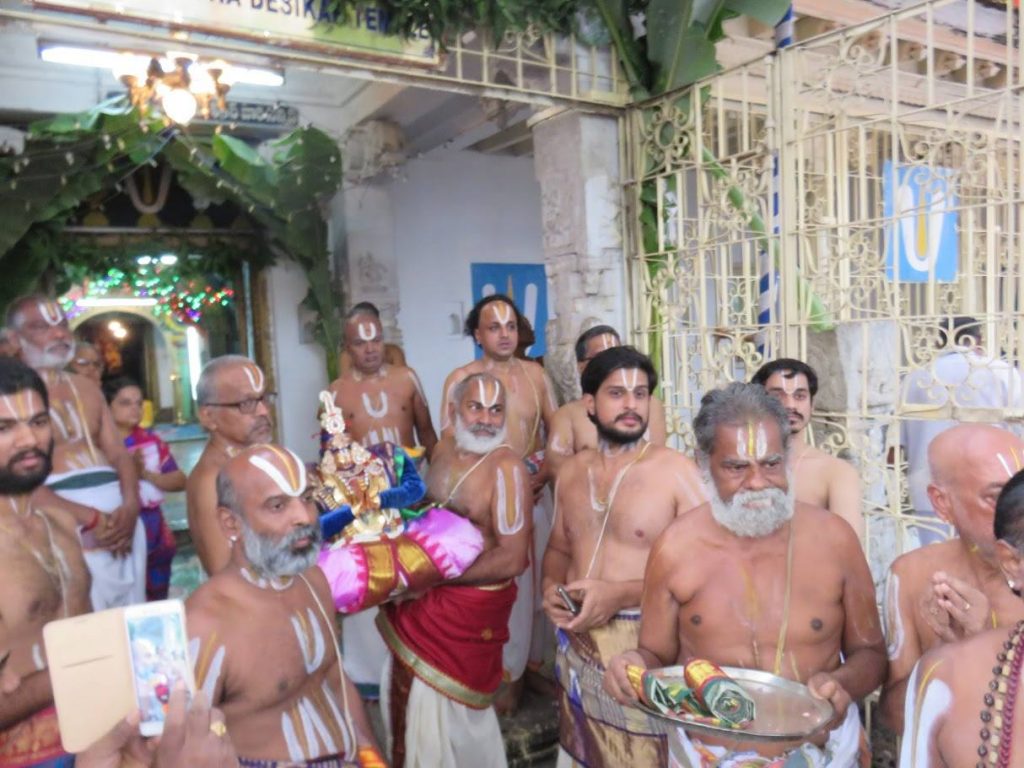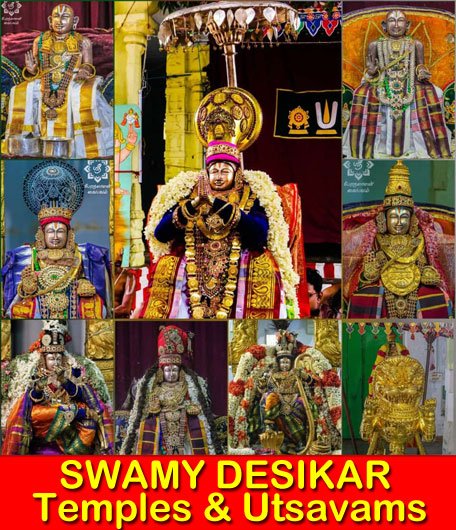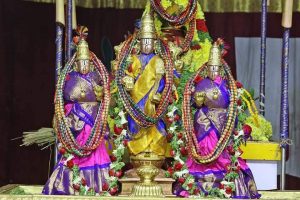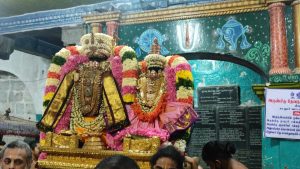At a time when Sri Vaishnava Sampradaya was facing many a challenge after the demise of Sri Ramanujacharya, Sri Vedanta Desika, an incarnation of Lord Vishnu’s Ghantavatara (divine bell), took birth to propagate Sri Ramanuja’s teachings.
Sri Ramanuja was the saviour of Sri Vaishnava Sampradaya. After him, Sri Vedanta Desika took upon himself the task of protecting and propagating the Sampradaya. He has taken the Visishtadwaita System all over the world like a river flow. Desika has proved that one need not be a sanyasi (saint) to serve God. Even when leading a marital life, one can be successful in the worship of Lord Narayana. In his hymns, Desika has explained the merits of Bhagavat Kainkaryam.
In Sanskrit, Desika means “Acharya”. In our Srivaishnava Sampradaya, there are numerous acharyas. It is only Swami Desika who is addressed respectfully as “Desika”.
In his hymn, Kumara Vaadacharya says his father Vedanta Desika is an incarnation of Lord Srinivasa, His Bell and Sri Bhagavat Ramanuja.
Prativadibhayankaram Anna says the Bell, which destroyed all other religions, was born as Swami Desika on the auspicious day of Lord’s Tirthavari (Chakrasnanam) on Bhadrapada Masa Sravanam day.
In his Sankalpa Suryodayam, Desika himself says people opine that he is an incarnation of Lord Narayana’s Bell (Ghantavatara). Though he became a genius with the blessings of Lord Hayagriva, thanks to the Acharya Krupa, he attained fame as a well-known director of Sri Vaishnava Sampradaya.
Swami Desika was a poet-philosopher-polymath, and has also proved his skills as a scientist, a logician, a mathematician, a dietician, a sculptor, a grammarian and a master of all arts and crafts. He has enthralled thousands of people with his adeptness at handling both simple, practical realities and sophisticated theological concepts. The quality of the 13th-century spiritual leader of the Sri Vaishnava sect in seeking knowledge tirelessly has made him a genius.
Sri Vedanta Desika was born in 1268 CE at Tooppul (Tiruthanga) near Kancheepuram in Tamil Nadu as Venkatanatha to Anantasuri and Totaramba, fulfilling a divine prophecy that the temple bell of Lord Venkateswara of Tirumala would incarnate as their son. He was born in the Vibhava Varsha, Bhadrapada (Purattasi) month in Shravana nakshatra, the birth star of Lord Venkateswara, hence he was named Venkatanatha. He was born to popularise the path of saranagati or ultimate surrender to Lord Narayana. In the childhood itself, Venkatanatha showed his brilliance to his acharyas.
At the age of 5, he began his formal studies under his maternal uncle, the great acharya, Atreya Ramanuja (Kidambi Appullar). By 20 years, he had mastered the Vedas with all six Vedangas and the 4000 Divya Prabhandam of 12 Azhwars.
He learnt Vedanta, Nyaya, Vaisheshika, Purva Mimamsa, Yoga and Sankhya. Later, he married Tirumangai.
Post- marriage, his acharya asked Venkatanadha to seek the grace of Garuda, the Veda Swaroopa, and taught him the Garuda Mantra. After the demise of Appullar, Swami Desika left Kancheepuram for Tiruvaheendirapuram, where he meditated and chanted the Garuda Mantra. He was blessed by Garuda, who initiated him into the mantra of Hayagriva, the horse-faced incarnation of Lord Vishnu, who presides over all knowledge. Garuda also presented an idol of Lord Hayagriva to Venkatanatha for worship. After meditating on Hayagriva Mantra, Venkatanatha was blessed with a vision of Hayagriva, who gave him the amrita of jnana. The next moment, sublime poetry surged forth from Venkatanatha’s tongue as the Hayagriva Stotra, his first work. Later he authored hundreds of works as jnana flowed freely from his mind. He wrote across languages, in Sanskrit, Tamil, Prakrit and Manipravalam. He wrote Garuda Panchasat, Devanayaka Panchasat, Achyutha Sathakam, Gopala Vimsathi. In Tamil, he wrote Mummanikkovai, Kandupa, Kazharpa, Ammanaipa, Oosarpa, Yesarpa, Navarathinamalai and Paramathabhangam.
In addition to stotras, his works include in the spheres of kavyas, natakas, gadyas, rahasya granthas, vedanta, vyakhyana, and anusthana.
Later he returned to Kancheepuram and wrote many works on Lord Varadaraja. On hearing the work of Tiruchinnamalai, an elated Lord Varadaraja presented his ‘Tiruchinam’ (sound blowing instrument) to Swami Desika. To remind the incident, even today only one Tiruchinnam is blown at the temple of Lord Varadaraja. The other one is used at Tooppul Sri Vedanta Desika Temple.
Desika also wrote many hymns on the deities situated in and around Kancheepuram.
The Hayagriva idol, presented to Sri Ramanuja by Goddess Saraswathi, reached Vedanta Desika through Appullar’s son-in-law Pundarikakshan.
In Srirangam, Adwaita scholars opposed the Ramanuja Siddhanta and prevented the conduct of Tiru Adhyayana Utsavam at Sri Ranganatha temple. Desika reached Srirangam to restore Ramanuja’s principles and defeat opponents. First, he visited Ramanuja’s shrine and wrote Yathirajasapthathi. Later he worshipped Lord Ranganatha and Goddess Ranganayaki. Then he was involved in Vaadam (arguments) over Ramanuja Siddhanta with opponents for eight days without a break and defeated them. Desika ensured that the Tiru Adhyayana Utsavam is conducted regularly at the temple. An elated Lord Ranganadha presented the title of Vedantacharya on Desika. Goddess Ranganayaki honoured him with the title ‘Sarvatantra Swatantra’.
Later Desika stayed in Srirangam and continued his good work of propagating Ramanuja’s principles. He wrote many original works, and wrote commentary on a large number of books. Many Vaishnavite scholars like Sudarsana Suri became happy and conferred the title of Kavitarkika Simham (a lion among poets) on Desika.
Each one of his 105 works is a gem and a reflection of his unparalleled eloquence and mastery. Some of the important works are the Paaduka Sahasram, Abheeti Stavam, Dehaleesa Stuti, Bhagawad Dhyana Sopanam, Aahara Niyamam, Hamsa Sandesam, Raghuveera Gadyam, Goda Stuti, Sudarsana Ashtakam, Vairagya Panchakam, Garuda Dandakam, Hayagriva Stotram and many more. His play Sankalpa Suryodayam reflects his mastery over dramaturgy.
In Kancheepuram, when a young boy wanted some money for his marriage, Swami Desika took him to the Perundevi Thayar temple and recited Sri Stuthi. Then gold coins started raining from the sky. Swami Desika thanked the Thayar for Her mercy.
When his fame reached all over the world, Madhava Vidyaranya invited Desika to adorn the Vijayanagara Sabha. However, Vedanta Desika spurned the offer of kingly hospitality and the wealth and fame, sending a five verse response, the Vairagya Panchakam.
His title of Sarvatantra Swatantra, the master of all arts and sciences, was constantly put to test in many ways. The challenges ranged from building a well with misshapen bricks to handling tantra prayogas to snake charmers who let their reptiles loose on him to a sculptor who challenged him to make a scale metal image of himself. In each of these he came out with flying colours.
When people were suffering from viral fever at Tirupputkuzhi, near Kancheepuram, Desika went there and wrote Sudarsanashtakam praying for their recovery. He also performed Sudarsana Homam and freed the people from their ailment.
His mastery over masonry saw him building a well, which can be seen till today at Desikar Tirumaligai in Tiruvaheendrapuram, near Cuddalore.
His Tamil work Prabhanda Saram describes the details of the birthplace, star, day and the works of 12 Azhwars. One who recites this will get the boon of reciting the entire Nalayira Divya Prabandham.
Desika and Tirumangai had a son whom they named Kumara Varada.
Desika’s Subhashita Nivi gives wise advice to us through small slokas. In this work, Desika talks about people whose company we should avoid. Desika never wrote anything that is opposed to Vedanta. He never compromised on Vedantic truths in order to achieve effect through his verses. Throughout all his works, this emphasis on Visishtadvaita is clearly seen. And this is true not just of the complex texts like Rahasyatrayasara, but even of the relatively simpler stotras too.
Vedanta Desika’s Hamsa Sandesam is a poem where Rama sends a swan as a messenger to Sita.
Desika’s Yadavabhyudaya has for its theme the story of Lord Krishna, starting from his birth. There are five mahakavyas in Sanskrit, but Vedanta Desika’s Yadavabhyudaya qualifies in every respect to be called the sixth mahakavya.
Desika was so described, because he was master in many languages. Desika has been lauded by many poets, each of whom gives a reason for reading Desika’s works.
One can bathe in the Ganges to purify oneself. But Desika’s works are an Akasa Ganga. Immersion in his works grants instant purity.
During Muhammadan invasions of Srirangam, Desika managed to flee with the last remaining copy of Srutaprakashika, Sudarshanasuri’s great commentary on Sri Ramanuja’s magnum opus, Sri Bhashya. He escaped to Melkote in Karnataka. Desika finally returned to Srirangam to spend his years in writing and teaching.
In the year 1369, at the ripe age of 101, Desika gave up his physical form. His legacy was continued by his sishyas including his son Kumara Varadacharya and others.
Desika’s son Kumara Varadachariar wrote a Thanian for Desika starting with “Srimaan Venkata nadharya”.
Another disciple Brahma Tantra Swatantra Jeeyar wrote a Thanian starting with “Ramanuja Dayapaatram”.
Sri Pillailokacharyar made a Thanian for Swami Desikan starting with “Seerondru Tooppul”








